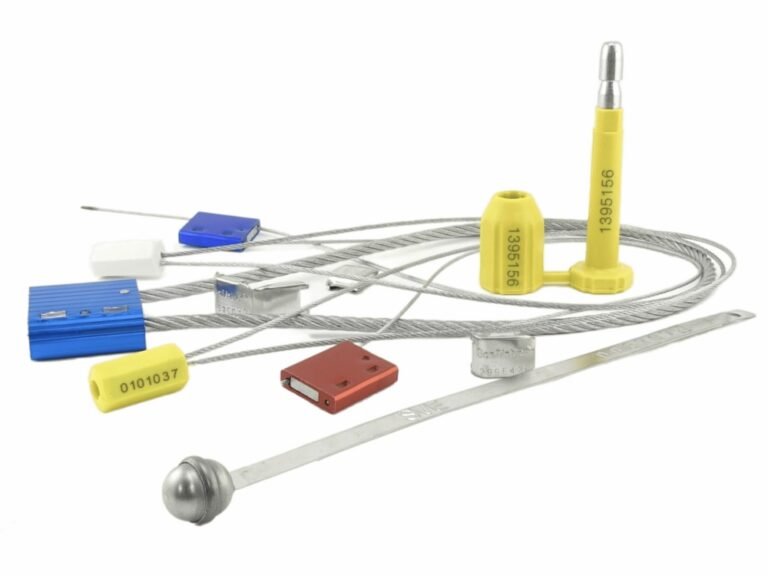You've sealed your shipment, but theft still occurs. Now you're in a costly dispute with your carrier, with no clear evidence of when the tampering happened, forcing you to absorb the huge financial loss.
A security seal’s true role is to serve as an immutable "contract enforcer." It transforms an invisible custody agreement into a physical token that must be verified at each handover, upgrading the supply chain from a fragile system of trust to a robust chain of evidence.
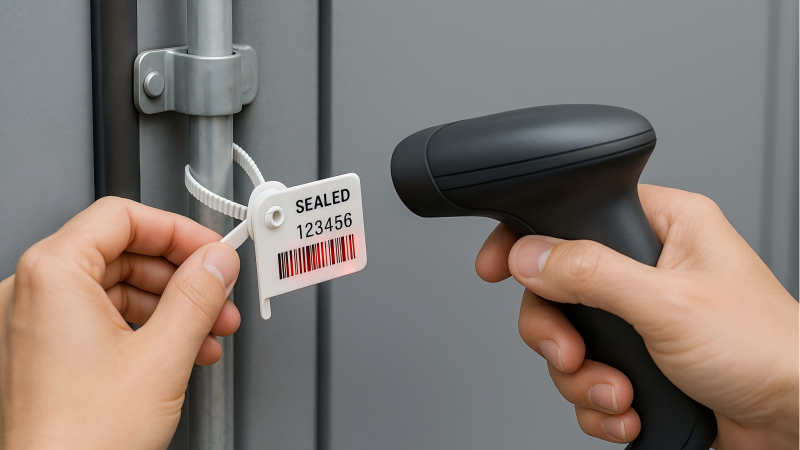
In my 15+ years in this industry, I've seen a fundamental misunderstanding of a security seal's role. It is not simply a physical lock. Its true function is to act as an immutable "contract enforcer." The seal’s sole mission is to transform an invisible agreement—the "duty of care" for cargo—into a tangible, physical token that must be verified at every single handover point. Its existence upgrades the entire supply chain from a fragile chain built on fuzzy trust to a legal evidence chain composed of clear, traceable points of responsibility.
How Is a Seal Both a Deterrent and a Data Point?
You see a seal as a simple lock, designed only to scare off thieves. This narrow view misses its most powerful function, leaving you vulnerable to sophisticated fraud or "mysterious losses" that you can't explain.
A security seal functions as both a visual deterrent and, more importantly, a unique data point. Its serial number acts as a digital fingerprint for the shipment, providing verifiable data for your logistics system and creating a permanent, unchangeable record.

The functional evolution of a seal from a simple lock to an information device is the key to understanding its modern role. It performs two jobs simultaneously.
1. The Physical Deterrent
This is the seal's most basic function. An intact, high-quality seal signals that the container is secured. It's a clear visual cue that discourages opportunistic theft—the most common type of cargo theft. A potential thief sees the seal and understands that they cannot access the contents without leaving obvious, undeniable evidence. They will almost always move on to an easier, unsealed target.
2. The Information Hub
This is the seal's most critical role. The unique serial number, often paired with a barcode, is a piece of data. This data point is logged when the seal is applied and is verified at every handover. This creates a digital breadcrumb trail. When this data is integrated into a Transportation Management System (TMS) or ERP system, the seal becomes a vital part of your data infrastructure, providing real-time information and a historical audit trail.
How Does a Seal Secure the Chain of Custody?
Your cargo passes through multiple hands: your warehouse, a trucking company, a port, a shipping line. You're worried because every handover is a point of vulnerability where responsibility is unclear.
A security seal codifies the chain of custody. It forces a formal check at each transfer point. The act of accepting a sealed container is a formal acknowledgment of responsibility, documented by verifying the seal's number and integrity.
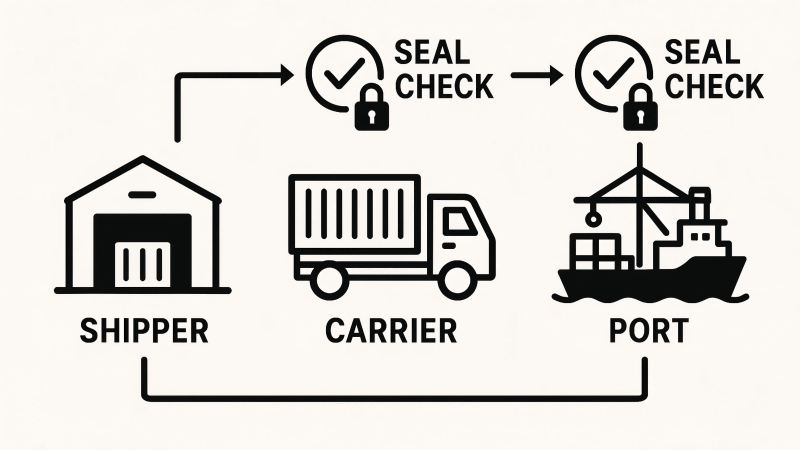
This is where the seal acts as a "contract enforcer." It makes the invisible transfer of liability tangible and observable. Here’s how it works in practice:
- Step 1 (Shipper): Your team loads the container, locks it with Seal #ABC12345, and records this number on the Bill of Lading. You have now created the "original state" contract.
- Step 2 (Carrier): The truck driver arrives. Before they sign to accept the container, they must verify two things: 1) A seal is present. 2) The number is #ABC12345. By signing, the driver’s company legally accepts responsibility for the cargo in its sealed state.
- Step 3 (Port/Consignee): At every subsequent handover, the next party repeats this verification process. They are accepting the "contract" and taking on the liability.
If a carrier tries to deliver a container with a broken seal or a different number, the receiving party can legally refuse to accept it, as the "contract" has been visibly broken. The point of failure in the chain is immediately identified.
How Does a Seal Mitigate Broader Business Risks?
You're focused on preventing theft, but what about other threats? You could be exposed to risks like product contamination, illegal smuggling, or brand damage from counterfeit goods entering your supply chain.
A security seal's role extends far beyond theft. It is a critical tool for risk management that helps mitigate contamination risks, protects against unauthorized introduction of contraband, and helps maintain brand integrity by securing the supply channel.
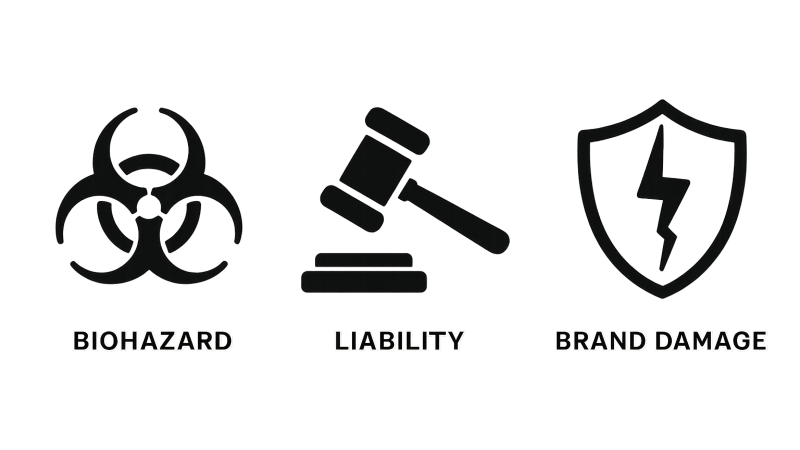
An intact seal is your proof that nothing was added to your shipment, just as much as it proves nothing was taken out. This is crucial for several industries.
- Food & Pharmaceuticals: For these industries, an unbroken seal is proof of sanitation and safety. It verifies that the controlled environment inside the container has not been compromised, protecting against contamination and ensuring regulatory compliance.
- Hazardous Materials: An intact seal proves that dangerous goods have not been tampered with, ensuring the safety of handlers and the public.
- Preventing Inbound Smuggling: A robust sealing strategy on inbound empty containers can help prevent your company from being unwittingly used to smuggle illegal goods. It provides a baseline security check on all equipment entering your facilities. This protects you from potentially catastrophic legal liability and fines from customs authorities.
- Brand Protection: For high-value brands, a sealed shipment provides confidence to distributors and retailers that the products they are receiving are authentic and have not been swapped with counterfeits.
How Do Seals Protect Your Company's Bottom Line?
You see the cost of seals as just another operational expense. You haven't calculated the significant return on investment that a proper sealing strategy provides.
Seals deliver a direct economic impact by reducing the frequency of cargo loss, lowering insurance premiums, and preventing costly legal disputes. They convert fuzzy "mysterious losses" into clear, insurable events, directly protecting your revenue and profitability.
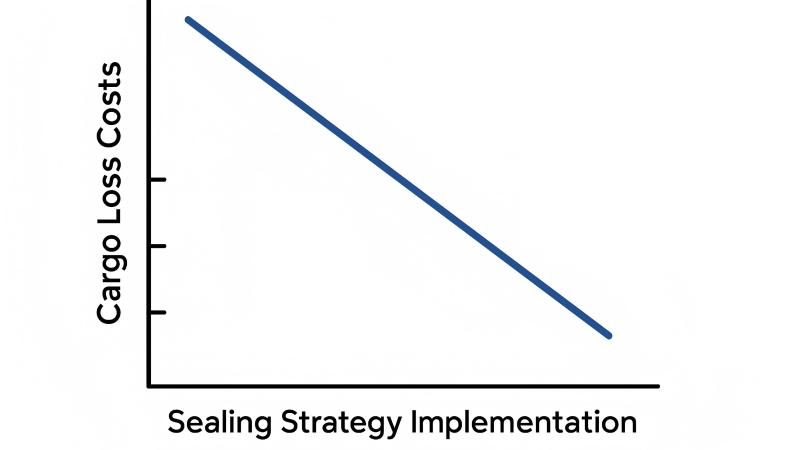
A seal is not a cost center; it is a profit protection tool. The financial benefits are tangible and measurable.
Direct Cost Savings
The most obvious benefit is preventing theft. If a $20,000 pallet is stolen from an unsealed truck, that money is simply gone. A $2 high-security seal makes that theft far less likely.
Indirect Cost Savings
- Lower Insurance Costs: Insurers love data and defined processes. A documented sealing protocol proves you are a lower-risk client, often resulting in reduced annual premiums.
- Reduced Legal Fees: When a sealed shipment is compromised, liability is clear. This drastically reduces the time and money spent on legal battles with carriers and other partners trying to determine who is at fault.
- Operational Efficiency: When a discrepancy occurs, a proper seal record tells you exactly where in the chain to investigate. This saves countless hours of administrative time that would otherwise be spent chasing down a "mysterious disappearance." I've watched clients cut down their investigation time for missing items by over 90% just by implementing a strict seal protocol.
How Do You Align Seal Function with Your Application?
You know you need a seal, but bolt seals, cable seals, plastic seals—the choices seem confusing. Choosing the wrong type of seal can provide a false sense of security and waste your money.
Choosing the right seal requires matching the seal's security level to the risk and value of the shipment. A high-security ISO 17712 bolt seal is for international containers, while a simple plastic pull-tight seal is for low-risk domestic totes.
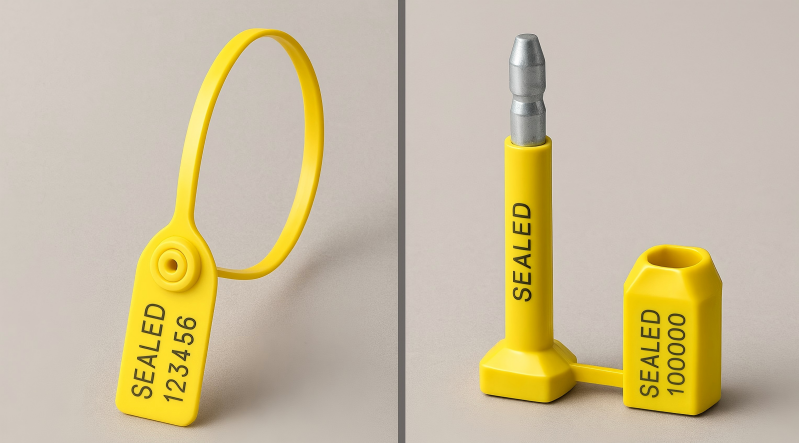
The function of the seal must align with its application. Here's a simple framework I use to help clients decide:
| Security Level | Seal Type | Primary Function | Common Application |
|---|---|---|---|
| High-Security | Bolt Seals, Heavy-Duty Cable Seals | Strong physical barrier + Data point | International shipping containers, high-value cross-country trucks. |
| Security | Standard Cable Seals, Metal Seals | Moderate barrier + Data point | Domestic long-haul trucks, rail cars, valuable air freight containers. |
| Indicative | Plastic Pull-Tight Seals, Meter Seals | Purely a data point (Indicates tampering) | Local delivery trucks, warehouse totes, roll cages, fire extinguishers. |
The question to ask is not "what is the strongest seal?" but "what is the appropriate level of evidence I need for this specific shipment?" For a local delivery of low-value goods, a plastic seal is sufficient. For a $250,000 shipment of electronics going overseas, anything less than a high-security bolt seal is professional negligence.
Conclusion
A security seal is not a lock. It is a procedural tool, a data point, and a contract enforcer that brings clarity and accountability to the supply chain, protecting your cargo and your bottom line.
Enforce Your Supply Chain Contract with ProtegoSeal
Don't leave your cargo's security to fuzzy trust. Implement a robust sealing strategy that creates a clear chain of evidence. At ProtegoSeal, we provide the high-security seals that act as the physical proof of your custody agreements. Contact us to build a supply chain based on verifiable responsibility.

